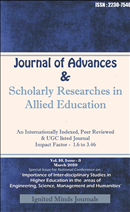Role of Advertising Standard Council of India in Promotion of Advertisement of FMCG
Keywords:
Advertising Standard Council of India (ASCI), Advertisement, FMCG IndustryAbstract
Advertising is a powerful tool of communication force, highly visible that helps to sells goods, services, and ideas etc. Advertising reflects the need of the times, whether we like it or not advertisements are seen everywhere. Although Advertising holds just one part of the entire promotional mixture, it is mostly regarded as the main face of a holistic marketing combination campaign set-up. Promotion or advertisement is the collaboration of all endeavors began by sellers for establishing information sources or outlets as well as continuation to augment the intensity of a particular commodity or service. In this paper we will use secondary data approach. The result of the study shows that ASCI have adopted a code for self-regulation in advertising in FMCG. The code is a commitment, a promise, to honest advertising and to fair competition in the market. Thus, the thinking among the advertising fraternity in FMCG was “Regulate yourself, or someone else will”.
References
Sidhu, L. S., Sharma, J. and Shivani (2015). Ethics in Advertising –An Indian Perspective. International Advanced Research Journal in Science, Engineering and Technology, 2(5).
Tandon, N. (2018). Growth of advertising industry in India. International Journal of Recent Scientific Research, 9(1), pp. 23622-23625.
Samuel, L. R. (2002). Postwar Television Advertising and the American dream. Austin: University of Texas Press.
Ciochetto, L. (2004). Advertising and globalisation in India. Retrieved from Swedish South Asian Studies Network: http://www.sasnet.lu.se/EASASpapers/7LynneCiochett o.pdf
Khandai, S. and Agrawal, B. (2012). Impact of Television Commercials upon the Purchase Behavior of Urban Indian Children. International Journal of Marketing and Technology, pp. 72-91.
Hemamalini, K. S. and Kurup, S. K. (2014). Effectiveness of Television Advertisement on Purchase Intention. International Journal of Innovative Research in Science, pp. 9416-9422.
Gopakumar, K. C. (2004). Advertising in Kerala & its influence on select consumer non-durables. Retrieved from: http://ietd.inflibnet.ac.in/bitstream/106 03/375/7/07_chapter2.pdf
Kanner, A. D. and Soule, R. G. (2016). Globalization, Corporate Culture and Freedom. Retrieved from Eco psychologist: www.ecopsychologist.com/publications -writings/Eco psychology -and-consumer-culture.
Majumder, A. (2015). TV ad volume grows 111%. Retrieved from Business Standard: http://www.business-standard.com/article/companies/tv-ad - volume -grows - 111-115102800016_1.html.
Bansal, S. (2015). Advertising expenditure on TV grows 21% in first half of 2015. Retrieved from Mint: http://www.livemint.com/Consumer/RjAvu3qr3pQQIV4vQCeVuK/Advertising -expenditure -on-TV -grows -21-in - first -half-of-201.html
Frith, K. T. and Mueller, B. (2010). Advertising and Societies: Global Issues. New York: Peter Lang.








